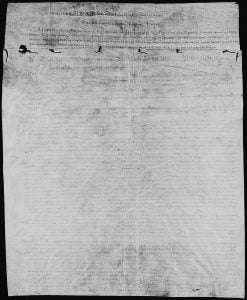
Treaty of August 3, 1795, also known as the Treaty of Greenville. The Treaty of Greenville set a precedent for objectives in future treaties with Native Americans — that is, obtaining cessions of land, advancing the frontier through white settlement, and obtaining more cessions through treaties. With the tribes’ surrender of most of Ohio, settlers began entering in Northwest Territory in greater numbers. In the near future, more treaties would further diminish Indians’ territory. 1
A treaty of peace between the United States of America and the Tribes of Indians, called the Wyandot, Delaware, Shawanoe, Ottawa, Chipewa, Putawatime, Miami, Eel River, Weea, Kickapoo, Piankashaw, and Kaskaskia.
To put an end to a destructive war, to settle all controversies, and to restore harmony and a friendly intercourse between the said United States, and Indian tribes; Anthony Wayne, major-general, commanding the army of the United States, and sole commissioner for the good purposes above-mentioned, and the said tribes of Indians, by their Sachems, chiefs, and warriors, met together at Greeneville, the head quarters of the said army, have agreed on the following articles, which, when ratified by the President, with the advice and consent of the Senate of the United States, shall be binding on them and the said Indian tribes.
Article 1. Henceforth all hostilities shall cease; peace is hereby established, and shall be perpetual; and a friendly intercourse shall take place, between the said United States and Indian tribes.
Article 2. All prisoners shall on both sides be restored. The Indians, prisoners to the United States, shall be immediately set at liberty. The people of the United States, still remaining prisoners among the Indians, shall be delivered up in ninety days from the date hereof, to the general or commanding officer at Greeneville, Fort Wayne or Fort Defiance; and ten chiefs of the said tribes shall remain at Greeneville as hostages, until the delivery of the prisoners shall be effected.
Article 3. The general boundary line between the lands of the United States, and the lands of the said Indian tribes, shall begin at the mouth of Cayahoga River, and run thence up the same to the portage between that and the Tuscarawas branch of the Muskingum; thence down that branch to the crossing place above Fort Lawrence; thence westerly to a fork of that branch of the great Miami river running into the Ohio, at or near which fork stood Loromie’s store, and where commences the portage between the Miami of the Ohio, and St. Mary’s river, which is a branch of the Miami, which runs into Lake Erie; thence a westerly course to Fort Recovery, which stands on a branch of the Wabash; then south-westerly in a direct line to the Ohio, so as to intersect that river opposite the mouth of Kentucke or Cuttawa River. And in consideration of the peace now established; of the goods formerly received from the United States; of those now to be delivered, and of the yearly delivery of goods now stipulated to be made hereafter, and to indemnify the United States for the injuries and expenses they have sustained during the war; the said Indians tribes do hereby cede and relinquish forever, all their claims to the lands lying eastwardly and southwardly of the general boundary line now described; and these lands, or any part of them, shall never hereafter be made a cause or pretence, on the part of the said tribes or any of th

